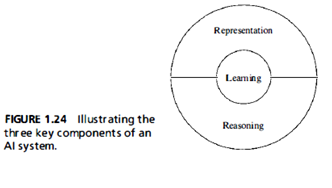SKEDSOFT
Introduction:-The goal of artificial intelligence (AI) is the development of paradigms or algorithms that require machines to perform cognitive tasks, at which humans are currently better. An AI system must be capable of doing three things: (1) store knowledge, (2) apply the knowledge stored to solve problems, and (3) acquire new knowledge through experience.
An AI system has three key components: representation, reasoning, and learning

1. Representation. The most distinctive feature of AI is probably the use of a language of symbol structures to represent both general knowledge about a problem domain of interest and specific knowledge about the solution to the problem.The kind of information supplied to the machine by the environment is usually imperfect. With the result that the learning element does not know in advance how to fill in missing details or to ignore details that are unimportant. The machine therefore operates by guessing, and then receiving feedback from the performance element. The feedback mechanism enables the machine to evaluate its hypotheses and revise them if necessary.
Machine learning may involve two rather different kinds of information processing:inductive and deductive. In inductive information processing, general patterns and rules are determined from raw data and experience. In deductive information processing, however, general rules are used to determine specific facts. Similarity-based learning uses induction, whereas the proof of a theorem is a deduction from known axioms and other existing theorems.
Explanation-based learning uses both induction and deduction. The importance of knowledge bases and the difficulties experienced in learning have led to the development of various methods for augmenting knowledge bases.
2. Reasoning. In its most basic form, reasoning is the ability to solve problems. For a system to qualify as a reasoning system it must satisfy certain conditions:-
• The system must be able to express and solve a broad range of problems and problem types.
• The system must be able to make explicit and implicit information known to it.
• The system must have a control mechanism that determines which operations to apply to a particular problem, when a solution to the problem has been obtained, or when further work on the problem should be terminated.2. Reasoning. In its most basic form, reasoning is the ability to solve problems.

Problem solving may be viewed as a searching problem. A common way to deal with "search" is to use rules, data, and control . The rules operate on the data, and the control operates on the rules.
3. Learning. In the simple model of machine learning depicted in Fig. 1 .25, the environment supplies some information to a learning element. The learning element then uses this information to make improvements in a knowledge base, and finally thehave to be perfect. Performance of the network degrades gracefully within a certain range. The network is made even more robust by virtue of the "coarse coding"where each feature is spread over several neurons feature is spread over several neurons.